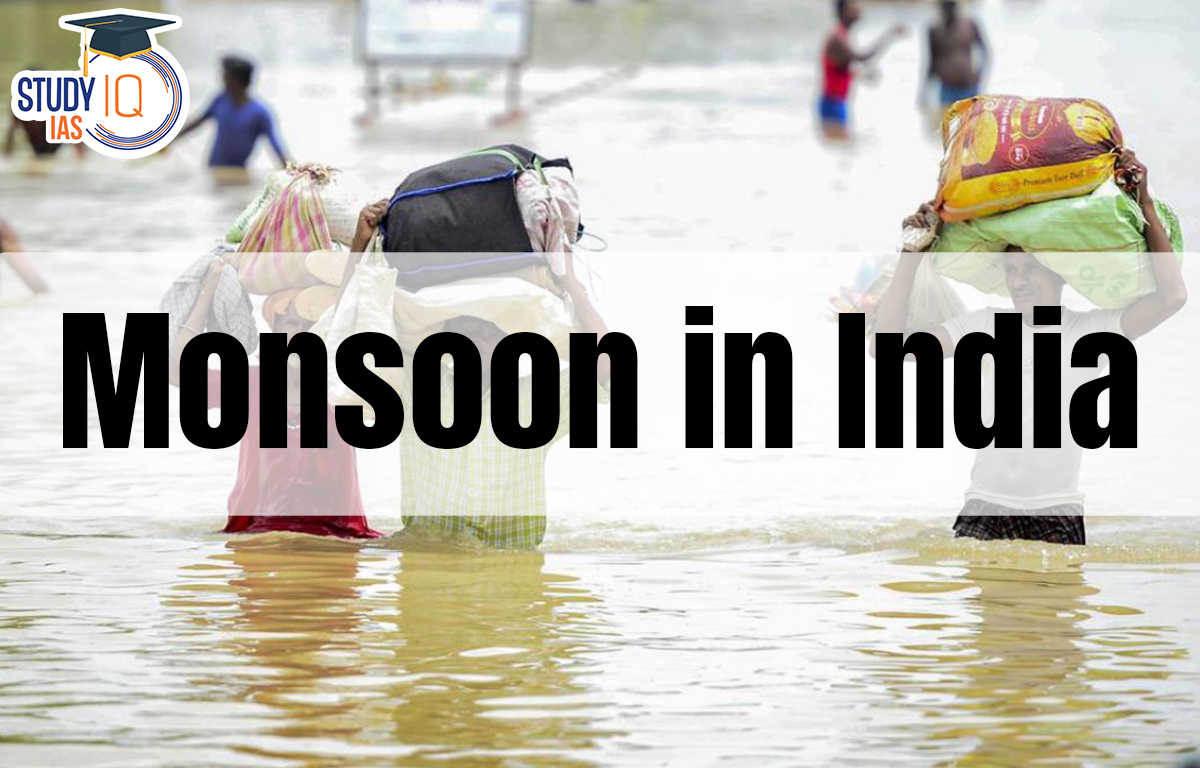Table of Contents
Monsoon in India Overview
The word “monsoon” comes from the Arabic word “mausim,” which means changing the direction of winds. Monsoons are Periodic(Seasonal) winds in which there is a complete reversal of the wind direction after every six months. In summer, these winds blow from the sea to the land, and in winter, they blow from the land to the sea.
In India, there are two types of monsoon winds:
- the northeast monsoon in winter and
- the southwest monsoon in summer.
The northeast monsoon happens because of a strong low-pressure system over the Tibetan Plateau, while the southwest monsoon is due to high-pressure cells over the Tibetan and Siberian plateaus. The southwest monsoon brings heavy rainfall to most of India, while the northeast monsoon mainly affects the southeastern coast (like the southern coast of Andhra Pradesh and Tamil Nadu). Countries like India, Indonesia, Bangladesh, and Myanmar get most of their annual rainfall during the southwest monsoon season, while Southeast China and Japan get more rain during the northeast monsoon season.
Why does India, have a Monsoon-type of Climate?
Latitude
The Tropic of Cancer runs through the middle of India dividing the country into two parts. It stretches from the Rann of Kutch in the west to Mizoram in the east. The southern part of India lies below the Tropic of Cancer is in the tropical zone. This means it generally has a warmer climate compared to the northern part of the country.
Altitude
The northern part of India is covered by mountains that are about 6000 meters high. These mountains are part of the Himalayas, which act as a barrier preventing cold winds from Central Asia from entering the Indian subcontinent. This helps to keep the region warmer.
Pressure and Winds
Pressure and surface winds, upper air circulation, Western cyclonic disturbances, and tropical cyclones are the main atmospheric conditions that affect the climate and weather in India.
North-East Trade winds
During the cold season, the North-East Trade Winds blow from the land to the sea over India. These winds carry very little moisture, so they bring very little rain.
South-West Monsoon
- Westerly flow, which mostly consists of the jet stream, controls the upper air circulation in the southwest region.
- Jet Stream: Also known as the Subtropical Westerly Jet Stream, jet streams are almost always found over 27° to 30° north latitude..
- The Jet stream’s speed fluctuates from approximately 110 km/h in the summer to 184 km/h in the winter.
- Western Cyclonic Disturbances: During the winter, the westerly flow from the Mediterranean region causes the western cyclonic disturbances.
- The weather in India’s north and northwest is typically influenced by the western cyclonic disturbances..
Features of Monsoon in India
Indian climate can be seen on two bases:
- on the basis of seasons
- Northeast Monsoon- Winter, mid, December to mid march, and
- Hot weather season, march to May
- Rainy season, june to September and
- Season of retreating monsoon, oct to mid-December
- on the basis of climate region- Summer, winter, monsoon, autumn and spring
India’s monsoon season is known for its unpredictable rainfall which can cause both floods and droughts. Some areas get over 200 cm of rain and face floods, while others get less than 50 cm and have semi-desert conditions.
The monsoon season starts from June to September. Rainfall varies greatly depending on the landscape. For example, the windward side of the Western Ghats gets more than 250 cm of rain, while the Eastern Himalayas and northeastern hill ranges also receive heavy rainfall. In contrast, western Rajasthan gets as little as 20 cm, while some parts of the Western Ghats and Northeast India get over 400 cm. As you move away from the sea, rainfall decreases. For example, rainfall drops from 119 cm in Kolkata to 76 cm in Allahabad and 56 cm in Delhi. Sometimes, the rains end earlier than expected, which can harm crops and make it difficult to plant winter crops.
Mechanism of Monsoon in India
Onset of the South-West Monsoon
With the apparent movement of the Sun, the ITCZ’s location moves both north and south of the equator. The ITCZ moves northward in June as the sun shines vertically over the Tropic of Cancer. Under the influence of Coriolis force, the southeast trade winds of the southern hemisphere cross the equator and begin to blow in a southwest to northeast direction.
As the winds pass over the warm Indian Ocean, they pick up moisture. The Indo-Gangetic Plain, where the ITCZ shifts to in July, receives a southwest monsoon that blows from the Arabian Sea and the Bay of Bengal. This position of the ITCZ is known as the Monsoon Trough.
The phenomena of the westerly jet stream leaving its position over the north Indian plain, south of the Himalayas is connected to the change in the ITCZ’s location. Only when the western jet stream has left the area does the easterly Jet Stream (Somali Jet) begin to develop along 15°N latitude. The burst of the Indian monsoon is attributed to this easterly jet stream. The relief and thermal low pressure over northwest India change the winds’ southwesterly direction as they near the land. Two branches of the monsoon approach the Indian continent:
The monsoon winds have an Arabian Sea branch that starts there.
The Arakan Hills along Myanmar’s coast redirect a significant section of the Bay of Bengal branch toward the Indian subcontinent. As a result, the monsoon approaches West Bengal and Bangladesh from the south and southeast rather than the south-west.
Rainfall tends to “break” during the monsoon, which is another characteristic connected to it. Rainfall during the monsoon season only lasts a few days at a time. There are stretches without rain in between them. These monsoon breaks are a result of the monsoon trough moving.
Retreating Monsoon in India
As the southwest monsoon season ends, the weather gets sunnier and warmer. The soil is still wet and the high temperature and humidity make the weather uncomfortable. This period is known as “October heat.”
In the second half of October, temperatures start to drop quickly, mainly in northern India. While the eastern part of the Peninsula gets rain, northern India stays dry as the monsoon leaves. October and November are the wettest months in this region.
Cyclonic depressions from the Andaman Sea move across the eastern coast of the southern Peninsula, causing widespread rain and damage. These tropical cyclones bring most of the rain to the Coromandel Coast. The northeast monsoon is important for farming and water supply in the south unlike the rest of the country, which gets rain from the southwest monsoon between June and September.
Monsoon in India Classical Theory
he Rig Veda mentions the monsoon, but it does not explain the monsoon system. Arab traders were the first to study monsoon winds scientifically. These patterns were important for Arab traders who traveled to India by sea for trade.
In the eleventh century, an Arab explorer named Al Masudi described how the monsoon winds and ocean currents in the north Indian Ocean reversed. In the seventeenth century, Sir Edmund Halley explained that the monsoon happens because of the different heating of continents and oceans.
Modern concept- The Dynamic concept of Flohn
The dynamic concept of the monsoon, proposed by Hermann Flohn in 1951, explains the monsoon as a result of seasonal changes in the planetary wind system.
- Seasonal Changes: The monsoon system in tropical Asia is influenced by the seasonal movement of the Inter-Tropical Convergence Zone (ITCZ). The ITCZ is a low-pressure area near the equator where trade winds from the northern and southern hemispheres meet.
- ITCZ Movement: During summer, the ITCZ moves northward to around 20°N-25°N latitudes, over the Gangetic plain in India. This shift creates a low-pressure area over northern and northwestern India, known as the monsoon trough1.
- Wind Direction: As the ITCZ moves, the southeast trade winds from the southern hemisphere cross the equator and are deflected by the Coriolis force. These winds then blow from the southwest to the northeast, bringing the southwest monsoon to India1.
- Winter Monsoon: In winter, the ITCZ moves southward, and the wind direction reverses. The winds blow from the northeast to the south west bringing the north east monsoon
Monsoon in India Air Mass Theory
The Air Mass Theory explains the Indian monsoon as a change in the tropical region’s winds.
- Planetary Winds: These are large winds that blow in the same direction all the time. In the tropics, they are called trade winds.
- ITCZ Movement: The Inter-Tropical Convergence Zone (ITCZ) is an area near the equator where trade winds from the north and south meet. The ITCZ moves north and south with the seasons.
- Monsoon Formation: In summer, the ITCZ moves north, bringing the southeast trade winds from the southern hemisphere across the equator. These winds turn right due to the Coriolis force, becoming the southwest monsoon winds that bring heavy rains to India.
- Moisture: As these winds travel over the warm Indian Ocean, they pick up moisture and release it as rain over India.
- In winter the ITCZ moves southward, and the wind reverse direction, becoming the northeast monsoon winds that bring rain to the southeastern coast of india.
Monsoon in India Jet Stream Theory
In winter, the highlands of Tibet split the subtropical westerly jet stream into two branches. The northern branch reaches between 20°N and 35°N. Sometimes, the tropical easterly jet stream (TEJ) from the anticyclone over Tibet reaches the southern tip of Peninsular India. Fast winds are also seen in other parts of the peninsula.
As the Mascarene High, a high-pressure area over the Indian Ocean, gets stronger, it causes winds to blow towards the low-pressure area in northern India. When these winds cross the equator, they change direction to become southwesterly and are known as the southwesterly summer monsoon.
Importance of Monsoon in India
In India, many dams, reservoirs, rivers, and canals depend on the monsoon season for water. The amount of rainfall directly affects forestry, fisheries, and other economic activities. Monsoon rains not only provide relief from the hot summer but also refresh the land.
The farmers are waiting for the monsoon rains. These rains are very important for farming and affect the agricultural calendar and social events, bringing people together. Many harvest festivals celebrate a good monsoon, such as Bihu in Assam, Pongal in Tamil Nadu, Onam in Kerala, and Lohri in Punjab. If the monsoon is good, it brings prosperity, if it fails, it can lead to hardship. The seasonal changes in wind and weather create a rhythmic cycle of seasons.
Other Indian Geography Topics
Other Fundamental Geography Topics


 Role of Teachers in Educations, Student ...
Role of Teachers in Educations, Student ...
 India's achievements after 75 years of I...
India's achievements after 75 years of I...
 Bal Gangadhar Tilak Biography, Achieveme...
Bal Gangadhar Tilak Biography, Achieveme...

























